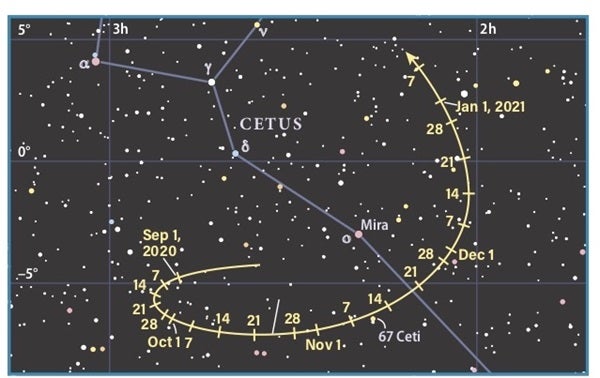It’s hard to explain my fascination with something that, through an eyepiece, looks like just another star. Maybe it’s the knowledge that the “star” is in fact a huge space rock dozens to a few hundred miles in diameter. Maybe it’s the pleasure I derive from following the night-to-night motion of an asteroid traversing the starry background. Who really knows?
If you’ve never seen an asteroid, though, it’s time to get in the game. So, this month, your assigned target is asteroid 471 Papagena. As November begins, it is just days past opposition in the constellation Cetus, but it remains brighter than 10th magnitude all month. Here are the steps you’ll need to take in order to move Papagena to your “observed” list.
Begin by assembling your asteroid-hunting gear. You’ll need a telescope rigged with a low-power eyepiece that yields a field of view at least 1° (about twice the diameter of the Moon) across. A big scope isn’t necessary; even a common 2.4-inch refractor will suffice. Add a clipboard, paper, a pencil, a red-filtered flashlight, and this finder chart, and you’re ready to go!
The first thing you’ll need to do once you’re set up is locate Papagena. Point your scope toward the bright star nearest its predicted location. A favorable window of opportunity occurs around November 10, when Papagena is less than a degree from the 5th-magnitude star 67 Ceti. Alternate views between your finder chart and eyepiece to “star-hop” your way to the asteroid’s predicted location. If you’ve done everything correctly, you should spot the 9th-magnitude space rock.
Don’t start celebrating yet, though. You can never be 100 percent sure you’ve spotted an asteroid until you’ve detected its motion. I don’t count an asteroid as observed unless I’ve seen it on two or three evenings to confirm its motion against the background stars. On more than one occasion, I was disappointed to discover that my suspect from the evening before hadn’t moved, forcing me to renew my search.
To be sure you’ve found Papagena, refer to the finder chart to study where it should appear over the next few nights. Take out your sketch pad and draw the field, including your candidate and field stars within at least a degree of its future path. (The fewer field stars, the better, as you might mistake them for Papagena on a later night.)
Confirmation comes on the next clear night when you revisit the field. If you see nothing where your suspect was the previous night, raise your fist in triumph. Now turn to tonight’s predicted location. If you see a “star” in that location and your sketch shows nothing was there the first night, raise both fists in triumph and write “Gotcha!” on the page. You’ve captured Papagena.
As is the case with its kindred asteroids, Papagena is much more than a stellar speck. With a diameter of over 90 miles (145 kilometers), it’s roughly comparable in size to the state of Connecticut. Fortunately for us, Papagena will never get closer than its opposition distance of 120 million miles (193 million km). A main-belt asteroid (one whose orbit lies between Mars and Jupiter), Papagena circles the Sun once every 4.9 years.
In catalogs, asteroids are assigned a number that indicates the order of their discovery. Ceres, the first asteroid discovered, therefore bears the designation 1 Ceres. And as you might expect, the brightest asteroids tended to be discovered first, so they were assigned the lowest numbers. But some slipped through the cracks, only coming to light later. One such elusive asteroid was Papagena, hence its relatively high designation of 471 Papagena. In fact, Papagena eluded visual discovery until it was photographically found by German astronomer Max Wolf on June 7, 1901. He named it after a character in the Mozart opera The Magic Flute.
I hope your experience with Papagena spurs your interest in asteroids. And if so, you’ll be glad to know that Astronomy features a bright, currently visible asteroid every month in our Sky This Month section. This month’s selection is asteroid 8 Flora.










